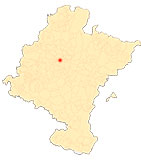Basilica of St. Ignatius of Loyola
By Ricardo Fernández Gracia
|
|
|
|
|
|
|
|
|
|
|
|
|
|
|
|
|
|
|
|
|
|
|
|
|
|
|
|
|
|
|
|
|
|
|
The primitive altarpiece: an itinerant piece
For the inauguration of the building an altarpiece was essential, which was the one that the Jesuits removed from their church, precisely in 1690, when a new one was commissioned to Francisco San Juan.
The old altarpiece, made around 1630-1635, was moved to the basilica. When the new one was made for the latter (1727), it was sold to the town of Azoz, where it is preserved, with an interesting Ignatian cycle of paintings based on engravings from the life of the saint, by Father Pedro de Ribadeneyra, published in Antwerp in 1610. The scenes depicted had been known in books, engravings and oratory since the beginning of the 17th century, in plenary session of the Executive Council period of "construction" of the sanctity of Ignatius of Loyola. The four Ignatian paintings of topic of the altarpiece constitute today the only cycle dedicated to the saint in Navarra, something that should not surprise us for having presided over the high school and the basilica of Pamplona. Three of them are copies of Ribadeneyra's work (Pedro de Ribadeneyra, S.J., Vita Sancti Patri Ignatii Loyolae, Religionis Societatis Iesu Fundatoris, Antwerp, apud Ioannem Gallaeum (1600-1676), 1610). Thus, we find the saint immersed in the waters to achieve the conversion of a sinner walking on the bridge, the apparition of Christ to St. Ignatius and the vision of the Virgin. The vision of the hanged man in Barcelona, whom he saved, has another iconographic source . The four scenes, following the Jesuit pedagogy that combines the image with the word, contain inscriptions of the time that identify the different themes.
Regarding the presence of the image of St. Mary Major of Rome in the altarpiece, we must remember that St. Francis Borgia defended its cult for its miraculous character, taking it as a point of support for his meditations and preaching. With the permission of Pope Pius V, Borgia ordered a copy to be made, under the supervision of Cardinal Borromeo, which in turn would be copied many times to send to different parts of the world, understanding that with those simulacra the spiritual power of the original was extended.
Regarding the painter of the canvases, we can venture the authorship of the Guipuzcoan Esteban de Iriarte who, in 1632, declared that he had to leave Guipuzcoa to work in Pamplona in a power of attorney and assignment to the Poor Clares of Tolosa on nine pictures that he had painted in San Francisco de Zarauz. As is known, Esteban de Iriarte was the father of Ignacio de Iriarte (Azcoitia, 1621-Seville, 1670), specialized in landscape painting, resident in Seville and considered one of the Guipuzcoan artists who achieved the greatest fame outside his homeland.
file Diocesan of Pamplona. Government of the Diocese. administrative office de Cámara. Boxes 293, 294, 295, 296 and 297.
ASCUNCE, E., Íñigo de Loyola, capitán español, y el castillo de Pamplona, Madrid, Aguado, 1939.
AZANZA LÓPEZ, J., La arquitectura religiosa del Barroco en Navarra, Pamplona, Government of Navarre, 1998.
EGUILLOR, J. R., Loyola, historia y arquitectura, San Sebastián, Etor, 1991.
FERNÁNDEZ GRACIA, R., El retablo barroco en Navarra, Pamplona, Government of Navarre, 2003.
FERNÁNDEZ GRACIA, R., "The Jesuits in Pamplona 1580-1767". Diario de Navarra, 28 April 2014, pp. 70-71.
FERNÁNDEZ GRACIA, R., "Heritage and identity (52). The basilica of San Ignacio in Pamplona". Diario de Navarra, 21 May 2021, pp. 62-63.
GARCÍA GAÍNZA, M.ª C. et al., Catalog Monumental de Navarra V. Merindad de Pamplona ***, Pamplona, Institución Príncipe de Viana, 1997.














